
The Great Lakes, also called the Great Lakes of North America, are a series of large interconnected freshwater lakes in the east-central interior of North America that connect to the Atlantic Ocean via the Saint Lawrence River. The five lakes are Superior, Michigan, Huron, Erie, and Ontario, and they are in general on or near the Canada–United States border. Hydrologically, Michigan and Huron are a single body of water joined at the Straits of Mackinac. The Great Lakes Waterway enables modern travel and shipping by water among the lakes.

A grape is a fruit, botanically a berry, of the deciduous woody vines of the flowering plant genus Vitis. Grapes are a non-climacteric type of fruit, generally occurring in clusters.
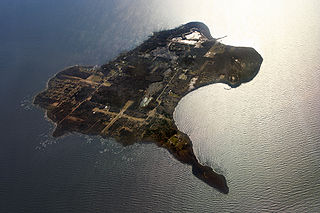
Kelleys Island is both a village in Erie County, Ohio, and the island which it fully occupies in Lake Erie. The island has a total area of 4.41 square miles (11.42 km2) and was formed by glacial action on limestone and dolomite.

An orchard is an intentional plantation of trees or shrubs that is maintained for food production. Orchards comprise fruit- or nut-producing trees that are generally grown for commercial production. Orchards are also sometimes a feature of large gardens, where they serve an aesthetic as well as a productive purpose. A fruit garden is generally synonymous with an orchard, although it is set on a smaller, non-commercial scale and may emphasize berry shrubs in preference to fruit trees. Most temperate-zone orchards are laid out in a regular grid, with a grazed or mown grass or bare soil base that makes maintenance and fruit gathering easy.
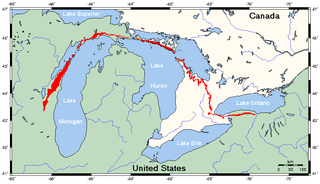
The Niagara Escarpment is a long escarpment, or cuesta, in Canada and the United States that starts from the south shore of Lake Ontario westward, circumscribes the top of the Great Lakes Basin running from New York through Ontario, Michigan, and Wisconsin. The escarpment is the cliff over which the Niagara River plunges at Niagara Falls, for which it is named.

The Concord grape is a cultivar derived from the grape species Vitis labrusca that are used as table grapes, wine grapes and juice grapes. They are often used to make grape jelly, grape juice, grape pies, grape-flavored soft drinks, and candy. The grape is sometimes used to make wine, particularly sacramental and kosher wine. Traditionally, most commercially produced Concord wines have been finished sweet, but dry versions are possible if adequate fruit ripeness is achieved. The grape is named after the town in Massachusetts where it was developed. The grapes are cultivated in many different parts of the world now.

The Maumee River is a river running in the United States Midwest from northeastern Indiana into northwestern Ohio and Lake Erie. It is formed at the confluence of the St. Joseph and St. Marys rivers, where Fort Wayne, Indiana has developed, and meanders northeastwardly for 137 miles (220 km) through an agricultural region of glacial moraines before flowing into the Maumee Bay of Lake Erie. The city of Toledo is located at the mouth of the Maumee. The Maumee was designated an Ohio State Scenic River on July 18, 1974. The Maumee watershed is Ohio's breadbasket; it is two-thirds farmland, mostly corn and soybeans. It is the largest watershed of any of the rivers feeding the Great Lakes, and supplies five percent of Lake Erie's water.

The Snowbelt, Snow Belt, Frostbelt, or Frost Belt is the region near the Great Lakes in North America where heavy snowfall in the form of lake-effect snow is particularly common. Snowbelts are typically found downwind of the lakes, principally off the eastern and southern shores.
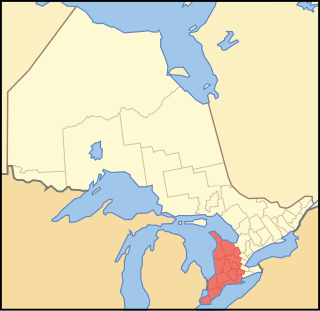
Southwestern Ontario is a secondary region of Southern Ontario in the Canadian province of Ontario. It occupies most of the Ontario Peninsula bounded by Lake Huron, including Georgian Bay, to the north and northwest; the St. Clair River, Lake St. Clair, and Detroit River, to the west; and Lake Erie to the south. To the east, on land, Southwestern Ontario is bounded by Central Ontario and the Golden Horseshoe. The region had a population of 2,796,367 in 2021.
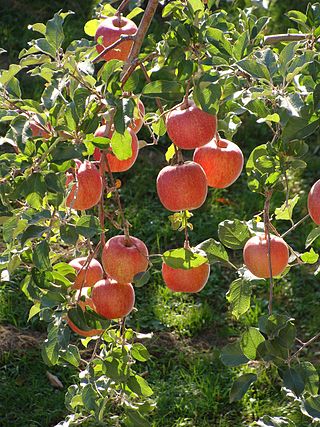
The Fuji apple is an apple cultivar developed by growers at the Tōhoku Research Station of the Ministry of Agriculture and Forestry in Fujisaki, Aomori, Japan, in the late 1930s, and brought to market in 1962. It originated as a cross between two American apple varieties—the Red Delicious and old Virginia Ralls Janet apples. According to the US Apple Association website it is one of the nine most popular apple cultivars in the United States. Its name is derived from the first part of the town where it was developed: Fujisaki.
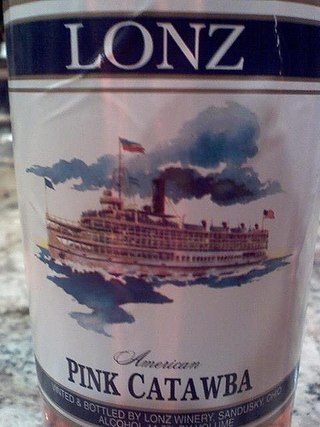
Catawba is a red American grape variety used for wine as well as juice, jams and jellies. The grape can have a pronounced musky or "foxy" flavor. Grown predominantly on the East Coast of the United States, this purplish-red grape is a likely a hybrid of the native American Vitis labrusca and the Vitis vinifera cultivar Semillon. Its exact origins are unclear but it seems to have originated somewhere on the East coast from the Carolinas to Maryland.

Vitis labrusca, the fox grape, is a species of grapevines belonging to the Vitis genus in the flowering plant family Vitaceae. The vines are native to eastern North America and are the source of many grape cultivars, including Catawba, Concord, Delaware, Isabella, Niagara, and many hybrid grape varieties such as Agawam, Alexander and Onaka. Among the characteristics of this vine species in contrast to the European wine grape Vitis vinifera are its "slip-skin" that allows the skin of the grape berries to easily slip off when squeezed, instead of crushing the pulp, and the presence of tendrils on every node of the cane. Another contrast with European vinifera is the characteristic "foxy" musk of V. labrusca, best known to most people through the Concord grape. This musk is not related to the mammalian fox, but rather to the strong, earthy aromas characteristic of the grapes that were known by early European-American settlers in the New World. The term "foxy" became a sort of catchall for the wine tasting descriptors used for these American wines that were distinct from the familiar flavors of the European viniferous wines.
The Ontario tobacco belt is the tobacco-growing region located in Norfolk County and eastern Elgin County in Southwestern Ontario, Canada. The region is close to the north shore of Lake Erie, with a moderate climate and sandy, silt-loam soils that are well-suited to a wide variety of crops.

Michigan wine refers to any wine that is made in the state of Michigan in the United States. As of 2020, there were 3,375 acres (1,366 ha) under wine-grape cultivation and over 200 commercial wineries in Michigan, producing 3 million US gallons (11,000,000 L) of wine. According to another count there were 112 operating wineries in Michigan in 2007.

Ontario wine is Canadian wine produced in the province of Ontario. The province has three official wine-growing regions, the Niagara Peninsula, the north shore of Lake Erie, and Prince Edward County, although wineries also exist in other regions in Ontario. Approximately two-thirds of Canada's vineyard acreage is situated in Ontario, with over 150 vineyards spread across 6,900 hectares. As a result, the province is the country's largest producer of wine, accounting for 62 per cent of Canadian wine production, and 68 per cent of all Canadian wine exports.
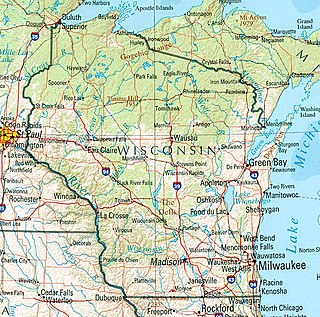
Wisconsin, a state in the Midwestern United States, has a vast and diverse geography famous for its landforms created by glaciers during the Wisconsin glaciation 17,000 years ago. The state can be generally divided into five geographic regions—Lake Superior Lowland, Northern Highland, Central Plain, Eastern Ridges & Lowlands, and Western Upland. The southwestern part of the state, which was not covered by glaciers during the most recent ice age, is known as the Driftless Area. The Wisconsin glaciation formed the Wisconsin Dells, Devil's Lake, and the Baraboo Range. A number of areas are protected in the state, including Devil's Lake State Park, the Apostle Islands National Lakeshore, and the Chequamegon–Nicolet National Forest.
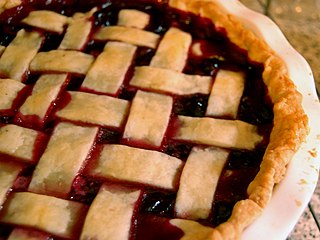
Grape pie is a type of fruit pie made from Concord grape and is part of harvest time traditions in the Finger Lakes region of New York in the United States. It is particularly sought after at the Naples Grape Festival, and can be found at various shops around town.

The energy sector of Ohio consists of thousands of companies and cities representing the oil, natural gas, coal, solar, wind energy, fuel cell, biofuel, geothermal, hydroelectric, and other related industries. Oil and natural gas accounts for $3.1 billion annually in sales while ethanol generates $750 million. Toledo is a national hub in solar cell manufacturing, and the state has significant production of fuel cells. In 2008, the state led the country in alternative energy manufacturing according to Site Selection Magazine, while the natural gas industry has experienced growth due to the expansion of shale gas.

Cotton Candy is the trademark for a variety of sweet white table grapes of the cultivar IFG Seven whose flavour has been compared to cotton candy. The grapes were developed by horticulturist David Cain and his team at Bakersfield, California-based fruit breeder International Fruit Genetics (IFG). The grapes are produced in California by grower Grapery, which began selling them in 2011.



















